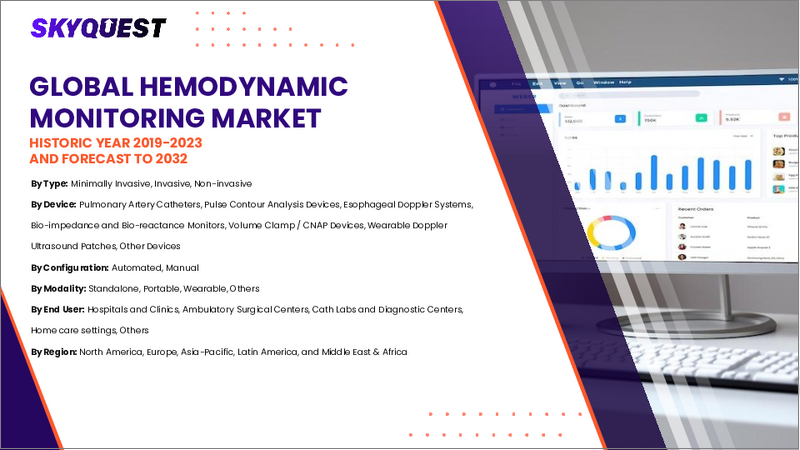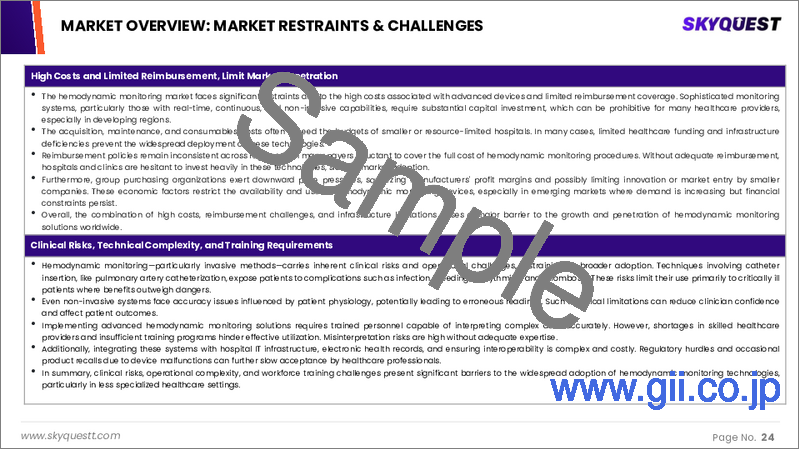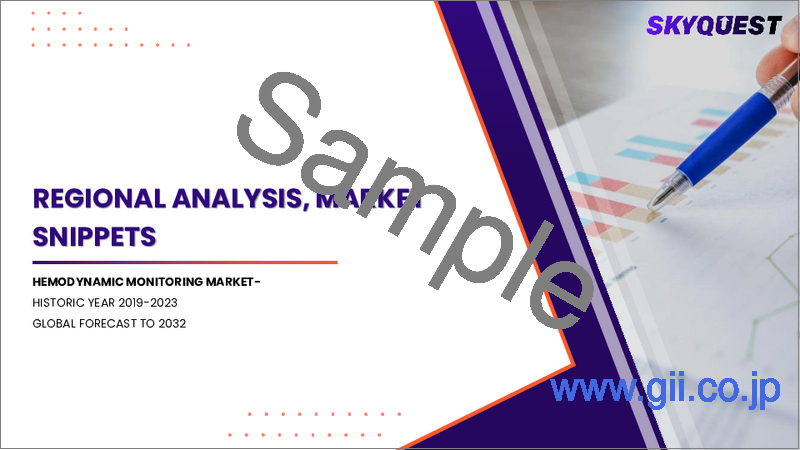|
|
市場調査レポート
商品コード
1736966
血行動態モニタリングの市場規模、シェア、成長分析、製品別、タイプ別、用途別、構成別、エンドユーザー別、流通チャネル別、地域別 - 産業予測、2025年~2032年Hemodynamic Monitoring Market Size, Share, and Growth Analysis, By Product, By Type, By Application, By Configuration, By End-User, By Distribution Channel, By Region - Industry Forecast 2025-2032 |
||||||
|
|||||||
| 血行動態モニタリングの市場規模、シェア、成長分析、製品別、タイプ別、用途別、構成別、エンドユーザー別、流通チャネル別、地域別 - 産業予測、2025年~2032年 |
|
出版日: 2025年05月22日
発行: SkyQuest
ページ情報: 英文 157 Pages
納期: 3~5営業日
|
全表示
- 概要
- 目次
血行動態モニタリングの世界市場規模は2023年に25億米ドルと評価され、2024年の26億6,000万米ドルから2032年までには43億7,000万米ドルに成長し、予測期間(2025年~2032年)のCAGRは6.4%で成長する見通しです。
血行動態モニタリング市場は、急速な技術進歩や心血管疾患の罹患率上昇に後押しされ、大幅な成長と変貌を遂げています。この市場は、患者の診断や治療の指針となる血液循環や心機能の評価に重点を置いています。注目すべき動向は、動脈カテーテルや肺動脈カテーテル、高度なセンサー技術など、低侵襲・非侵襲のモニタリング技術が好まれるようになっていることです。さらに、遠隔モニタリングソリューションの人気の高まりとともに、これらのモニタリングシステムと電子カルテとの統合が市場の拡大を促進しています。正確でリアルタイムの患者モニタリングに対する需要は、ヘルスケア成果の向上への全体的なシフトを反映し、今後も血行動態モニタリング分野の成長を牽引していくと思われます。
目次
イントロダクション
- 調査の目的
- 調査範囲
- 定義
調査手法
- 情報調達
- 二次と一次データの方法
- 市場規模予測
- 市場の前提条件と制限
エグゼクティブサマリー
- 世界市場の見通し
- 供給と需要の動向分析
- セグメント別機会分析
市場力学と見通し
- 市場概要
- 市場規模
- 市場力学
- 促進要因と機会
- 抑制要因と課題
- ポーターの分析
主要な市場の考察
- 主要な成功要因
- 競合の程度
- 主要な投資機会
- 市場エコシステム
- 市場の魅力指数(2024年)
- PESTEL分析
- マクロ経済指標
- 価格分析
- 技術分析
- 規制分析
血行動態モニタリング市場規模:製品別・CAGR(2025年~2032年)
- 市場概要
- テ血行動態モニタリングシステム
- バイタルサインモニター
- パルスオキシメーター
- カテーテル
- 消耗品・アクセサリー
血行動態モニタリング市場規模:タイプ別・CAGR(2025年~2032年)
- 市場概要
- 非侵襲性血行動態モニタリング
- 低侵襲性血行動態モニタリング
- 侵襲性血行動態モニタリング
血行動態モニタリング市場規模:用途別・CAGR(2025年~2032年)
- 市場概要
- 病院ベースのモニタリング
- 実験室ベースのモニタリング
- 在宅モニタリング
血行動態モニタリング市場規模:構成別・CAGR(2025年~2032年)
- 市場概要
- 自動
- 手動
血行動態モニタリング市場規模:エンドユーザー別・CAGR(2025年~2032年)
- 市場概要
- 病院
- 外来手術センター
- 介護施設
- 在宅治療
- 医療機関
- リハビリテーションセンター
- その他
血行動態モニタリング市場規模:流通チャネル別・CAGR(2025年~2032年)
- 市場概要
- オフライン
- オンライン
血行動態モニタリング市場規模・CAGR(2025年~2032年)
- 北米
- 米国
- カナダ
- 欧州
- ドイツ
- スペイン
- フランス
- 英国
- イタリア
- その他欧州地域
- アジア太平洋
- 中国
- インド
- 日本
- 韓国
- その他アジア太平洋
- ラテンアメリカ
- ブラジル
- その他ラテンアメリカ地域
- 中東・アフリカ
- GCC諸国
- 南アフリカ
- その他中東・アフリカ
競合情報
- 上位5社の比較
- 主要企業の市場ポジショニング(2024年)
- 主な市場企業が採用した戦略
- 最近の市場動向
- 企業の市場シェア分析(2024年)
- 主要企業の企業プロファイル
- 企業の詳細
- 製品ポートフォリオ分析
- 企業のセグメント別シェア分析
- 収益の前年比比較(2022年~2024年)
主要企業プロファイル
- Edwards Lifesciences Corporation(USA)
- Koninklijke Philips N.V.(Netherlands)
- GE HealthCare(USA)
- Getinge AB(Sweden)
- Baxter International Inc.(USA)
- Dragerwerk AG & Co. KGaA(Germany)
- ICU Medical, Inc.(USA)
- Masimo Corporation(USA)
- Nihon Kohden Corporation(Japan)
- Deltex Medical Group Plc.(UK)
- Osypka Medical GmbH(Germany)
- CNSystems Medizintechnik GmbH(Austria)
- NI Medical(Israel)
- Schwarzer Cardiotek GmbH(Germany)
- Abbott Laboratories(USA)
- Medtronic plc(Ireland)
- Boston Scientific Corporation(USA)
- Tensys Medical, Inc.(USA)
- Caretaker Medical(USA)
- Mindray Medical International Limited(China)
結論と提言
Global Hemodynamic Monitoring Market size was valued at USD 2.5 billion in 2023 and is poised to grow from USD 2.66 billion in 2024 to USD 4.37 billion by 2032, growing at a CAGR of 6.4% during the forecast period (2025-2032).
The hemodynamic monitoring market is undergoing substantial growth and transformation, propelled by rapid technological advancements and a rising incidence of cardiovascular diseases. This market focuses on assessing blood circulation and cardiac function, which is essential for guiding patient diagnostics and treatment. A notable trend is the increasing preference for minimally invasive and non-invasive monitoring techniques, including arterial and pulmonary artery catheters, as well as advanced sensor technologies. Furthermore, the integration of these monitoring systems with electronic health records, alongside the growing popularity of remote monitoring solutions, is enhancing market expansion. The demand for precise and real-time patient monitoring will likely continue to drive growth in the hemodynamic monitoring sector, reflecting an overall shift towards improved healthcare outcomes.
Top-down and bottom-up approaches were used to estimate and validate the size of the Global Hemodynamic Monitoring market and to estimate the size of various other dependent submarkets. The research methodology used to estimate the market size includes the following details: The key players in the market were identified through secondary research, and their market shares in the respective regions were determined through primary and secondary research. This entire procedure includes the study of the annual and financial reports of the top market players and extensive interviews for key insights from industry leaders such as CEOs, VPs, directors, and marketing executives. All percentage shares split, and breakdowns were determined using secondary sources and verified through Primary sources. All possible parameters that affect the markets covered in this research study have been accounted for, viewed in extensive detail, verified through primary research, and analyzed to get the final quantitative and qualitative data.
Global Hemodynamic Monitoring Market Segments Analysis
Global Hemodynamic Monitoring Market is segmented by Product, Type, Application, Configuration, End-User, Distribution Channel and region. Based on Product, the market is segmented into Hemodynamic Monitoring Systems, Vital Sign Monitors, Pulse Oximeters, Catheters and Consumables and Accessories. Based on Type, the market is segmented into Non-Invasive Hemodynamic Monitoring, Minimally Invasive Hemodynamic Monitoring and Invasive Hemodynamic Monitoring. Based on Application, the market is segmented into Hospitals-Based Monitoring, Laboratory-Based Monitoring and Home-Based Monitoring. Based on Configuration, the market is segmented into Automated and Manual. Based on End-User, the market is segmented into Hospitals, Ambulatory Surgical Centers, Nursing Homes, Homecare, Medical Institutions, Rehabilitation Centers and Others. Based on Distribution Channel, the market is segmented into Offline and Online. Based on region, the market is segmented into North America, Europe, Asia Pacific, Latin America and Middle East & Africa.
Driver of the Global Hemodynamic Monitoring Market
A key factor propelling the global hemodynamic monitoring market is the rising incidence of cardiovascular diseases alongside an aging demographic. Conditions like heart failure and hypertension are becoming increasingly common worldwide, resulting in a heightened demand for advanced hemodynamic monitoring systems. As the population ages, the prevalence of these conditions is predicted to rise further, intensifying the need for precise and continuous monitoring of patients' hemodynamic parameters. Additionally, technological innovations have facilitated the creation of minimally invasive and non-invasive monitoring devices, enhancing their accessibility and acceptance among patients, ultimately contributing to market expansion.
Restraints in the Global Hemodynamic Monitoring Market
One of the major challenges facing the global hemodynamic monitoring market is the prohibitive cost of these devices and restricted reimbursement coverage. The expense associated with hemodynamic monitoring systems and their necessary consumables can create a significant financial strain for both healthcare providers and patients alike. Furthermore, limited reimbursement options in various regions can impede the adoption of these essential technologies, particularly in healthcare environments with restricted budgets. The combination of high initial investments, ongoing operational costs, and uncertainty around reimbursement policies poses a significant barrier to the market's expansion. Collaboration between manufacturers and healthcare policymakers is essential to devise affordable solutions and create supportive reimbursement frameworks to enhance the utilization of hemodynamic monitoring devices.
Market Trends of the Global Hemodynamic Monitoring Market
The global hemodynamic monitoring market is witnessing a notable transformation, significantly influenced by the rising emphasis on patient-centric care and technological advancements. A key trend is the increasing preference for minimally invasive and non-invasive techniques, which enhance patient comfort while delivering precise, real-time cardiovascular data. This evolution in monitoring is fueled by demands for improved clinical outcomes and reduced complications. Moreover, the market is experiencing a surge in the adoption of advanced technologies, including wireless and remote patient monitoring systems, enabling healthcare professionals to efficiently track hemodynamic information from afar. Additionally, the proliferation of portable and handheld devices is facilitating point-of-care assessments, which further supports continuous monitoring across diverse healthcare environments.
Table of Contents
Introduction
- Objectives of the Study
- Scope of the Report
- Definitions
Research Methodology
- Information Procurement
- Secondary & Primary Data Methods
- Market Size Estimation
- Market Assumptions & Limitations
Executive Summary
- Global Market Outlook
- Supply & Demand Trend Analysis
- Segmental Opportunity Analysis
Market Dynamics & Outlook
- Market Overview
- Market Size
- Market Dynamics
- Drivers & Opportunities
- Restraints & Challenges
- Porters Analysis
- Competitive rivalry
- Threat of substitute
- Bargaining power of buyers
- Threat of new entrants
- Bargaining power of suppliers
Key Market Insights
- Key Success Factors
- Degree of Competition
- Top Investment Pockets
- Market Ecosystem
- Market Attractiveness Index, 2024
- PESTEL Analysis
- Macro-Economic Indicators
- Pricing Analysis
- Technology Analysis
- Regulatory Analysis
Global Hemodynamic Monitoring Market Size by Product & CAGR (2025-2032)
- Market Overview
- Hemodynamic Monitoring Systems
- Vital Sign Monitors
- Pulse Oximeters
- Catheters
- Consumables and Accessories
Global Hemodynamic Monitoring Market Size by Type & CAGR (2025-2032)
- Market Overview
- Non-Invasive Hemodynamic Monitoring
- Minimally Invasive Hemodynamic Monitoring
- Invasive Hemodynamic Monitoring
Global Hemodynamic Monitoring Market Size by Application & CAGR (2025-2032)
- Market Overview
- Hospitals-Based Monitoring
- Laboratory-Based Monitoring
- Home-Based Monitoring
Global Hemodynamic Monitoring Market Size by Configuration & CAGR (2025-2032)
- Market Overview
- Automated
- Manual
Global Hemodynamic Monitoring Market Size by End-User & CAGR (2025-2032)
- Market Overview
- Hospitals
- Ambulatory Surgical Centers
- Nursing Homes
- Homecare
- Medical Institutions
- Rehabilitation Centers
- Others
Global Hemodynamic Monitoring Market Size by Distribution Channel & CAGR (2025-2032)
- Market Overview
- Offline
- Online
Global Hemodynamic Monitoring Market Size & CAGR (2025-2032)
- North America (Product, Type, Application, Configuration, End-User, Distribution Channel)
- US
- Canada
- Europe (Product, Type, Application, Configuration, End-User, Distribution Channel)
- Germany
- Spain
- France
- UK
- Italy
- Rest of Europe
- Asia Pacific (Product, Type, Application, Configuration, End-User, Distribution Channel)
- China
- India
- Japan
- South Korea
- Rest of Asia-Pacific
- Latin America (Product, Type, Application, Configuration, End-User, Distribution Channel)
- Brazil
- Rest of Latin America
- Middle East & Africa (Product, Type, Application, Configuration, End-User, Distribution Channel)
- GCC Countries
- South Africa
- Rest of Middle East & Africa
Competitive Intelligence
- Top 5 Player Comparison
- Market Positioning of Key Players, 2024
- Strategies Adopted by Key Market Players
- Recent Developments in the Market
- Company Market Share Analysis, 2024
- Company Profiles of All Key Players
- Company Details
- Product Portfolio Analysis
- Company's Segmental Share Analysis
- Revenue Y-O-Y Comparison (2022-2024)
Key Company Profiles
- Edwards Lifesciences Corporation (USA)
- Company Overview
- Business Segment Overview
- Financial Updates
- Key Developments
- Koninklijke Philips N.V. (Netherlands)
- Company Overview
- Business Segment Overview
- Financial Updates
- Key Developments
- GE HealthCare (USA)
- Company Overview
- Business Segment Overview
- Financial Updates
- Key Developments
- Getinge AB (Sweden)
- Company Overview
- Business Segment Overview
- Financial Updates
- Key Developments
- Baxter International Inc. (USA)
- Company Overview
- Business Segment Overview
- Financial Updates
- Key Developments
- Dragerwerk AG & Co. KGaA (Germany)
- Company Overview
- Business Segment Overview
- Financial Updates
- Key Developments
- ICU Medical, Inc. (USA)
- Company Overview
- Business Segment Overview
- Financial Updates
- Key Developments
- Masimo Corporation (USA)
- Company Overview
- Business Segment Overview
- Financial Updates
- Key Developments
- Nihon Kohden Corporation (Japan)
- Company Overview
- Business Segment Overview
- Financial Updates
- Key Developments
- Deltex Medical Group Plc. (UK)
- Company Overview
- Business Segment Overview
- Financial Updates
- Key Developments
- Osypka Medical GmbH (Germany)
- Company Overview
- Business Segment Overview
- Financial Updates
- Key Developments
- CNSystems Medizintechnik GmbH (Austria)
- Company Overview
- Business Segment Overview
- Financial Updates
- Key Developments
- NI Medical (Israel)
- Company Overview
- Business Segment Overview
- Financial Updates
- Key Developments
- Schwarzer Cardiotek GmbH (Germany)
- Company Overview
- Business Segment Overview
- Financial Updates
- Key Developments
- Abbott Laboratories (USA)
- Company Overview
- Business Segment Overview
- Financial Updates
- Key Developments
- Medtronic plc (Ireland)
- Company Overview
- Business Segment Overview
- Financial Updates
- Key Developments
- Boston Scientific Corporation (USA)
- Company Overview
- Business Segment Overview
- Financial Updates
- Key Developments
- Tensys Medical, Inc. (USA)
- Company Overview
- Business Segment Overview
- Financial Updates
- Key Developments
- Caretaker Medical (USA)
- Company Overview
- Business Segment Overview
- Financial Updates
- Key Developments
- Mindray Medical International Limited (China)
- Company Overview
- Business Segment Overview
- Financial Updates
- Key Developments






